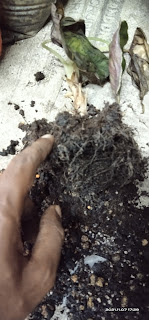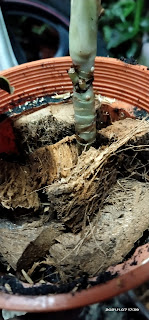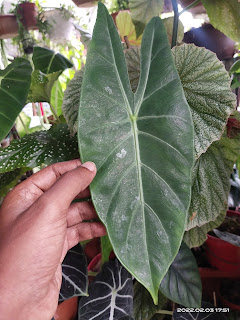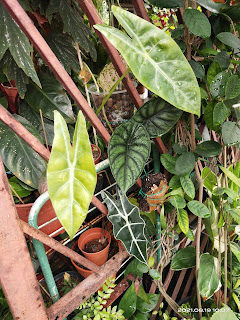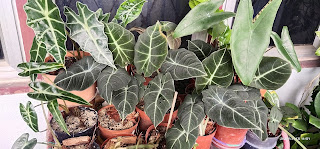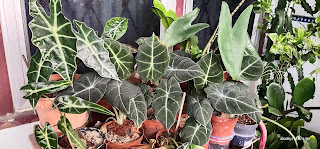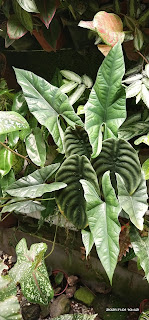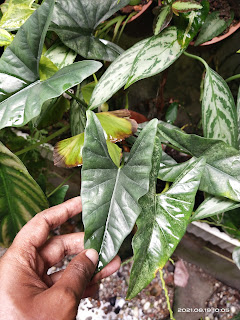INTRODUCTION:
I often get a lot of queries on how to repot Jewel Alocasia, the very fact is that at most if not all these plants that have been produced from the nurseries have used only cocopeat as medium which is not suitable for long-term condition for these types of Jewel Alocasia, all the more when introduced in the garden conditions where it is too wet and too hot in the same time - turning the potting media becoming too wet causing root rot or too dry that the roots are unable to absorb proper nutrients.
Hence repotting them to the correct media ensures the longevity of the plant life and these can grow and be maintained for many years to come.
POTTING MEDIA : MATERIALS

COCONUT HUSK CHIPS
After years of experience with many trial and errors, I finally came the most successful candidate - where it works best for me. Of course, different gardeners will propose and use based on their experience and their garden condition - in my context. I find the best that works for me are coco-chips. Do not get me wrong, it is not the same with using cocopeat or fiber. I strong discourage gardeners to use purely cocopeat as these retain too much water for long-term duration causing root and stem rot.
However, coconut chips alone will not work as it would be too dry and sparse - hence it need to be mixed with other material.
Here I use, in rough estimation of 50-75% coconut chips mixed with sand and compost.
RIVER SAND
I find River sand works best, the one that I chose are the slightly granule type and not the fine dust sand. These really helps to regulate the breathing process for the roots. You can use perlite as a substitute however I find perlite are quite light and may easily washed off when accidentally sprayed / watered strongly on the pot. Also they may easily float which doesn't really help in keeping the density in the potting medium.
Apart from Sand or Perlite - fine coarse pumice or even aquarium fine pebbles or pebbles wash stones can be used though I find these are quite expensive based on the weight and quantity sold. Also washed construction sand does work - however you may have to get the denser coarse material more in the mix comparison to the fine sandy parts.
Another addition is LECA BALLS however it doesn't retain much moisture as needed in comparison to coconut chips - you can add leca balls together in the mix but not solely unless the leca balls are exposed to constant watering system at the bottom as these regulate proper moisture.
Picture Above:
Here I have unpotted and uprooted the dying Jewel Alocasia. Just in time to save the plant from dying as I can notice the soil medium is too dense and too wet which may cause root rot easily even though it may have been watered once a week. The medium is retaining too much water.
The current medium used here is regular potting mix.
After removing the medium, I had carefully washed the root ball to check if there are any sign of root rot which can be detrimental to the plant. These had some dead rotting root branches in some section which I had carefully cut and removed them off from the main root structure.
I often layer the medium first, the first layer - I would put the coconut chip, at times, I would also put in a thin layer of compost and another thin layer of coconut chips again.
After that carefully lay the root ball. Normally - I would place the plant at the side of the pot, giving more support for the plant to lean against the pot wall.
After this, it is the sand followed by a little pieces of charcoal to deter the rot problem. You can skip the charcoal if you don't have it - I'm just using it as additional. (Charcoal chips - optional)
Then, it is just a slight constant layering of chips, sand and chips until the whole root ball is stabled and unexposed, you can lightly compress the mix by hand and add more of these potting medium until the pot is 90% full - do keep a little space for watering as you don't want the medium to wash down from the when watering.
This is how it looks like when it is fully done, Do try to avoid trimming off the dying leaves as it may trigger stress for the plant & this can cause the plant especially the Jewel Alocasia types to get into dormancy - they they trigger into dormancy - refrain from watering - just keeping the medium moist once a week. It is ok if the medium becomes fully dry before the next watering as the whole thing is just root ball and stem.
Over-watering in the dormancy stage can cause rot problems which can be fatal to the plant - hence ensuring the right medium for this condition saves the plant from dying.
This is still in the experimental stage and I find that this method is very successful.
What I do is, place a transparent plastic cup at the bottom of the drainage of the pot and just ever so slightly - making sure that the water is just touching the base of the pot - keeping the moisture intact as not to totally dried out.
I do water these in the pot - from the top of the medium keeping the whole pot wet but just once a week. The next watering - I make sure the top medium is fully dried before watering again. Usually once a week is considered very ideal.
Picture Above:
Shown here where the plant had almost died - I only had a small tuber which had gone dormant, here I just used coconut chips and leca balls and the plant had rejuvenated from dormancy after 3-4 months. Of course - I had the choice of ditching this dying plant and start all over again purchasing a new one however it was a trending plant then and these were sold very expensive during that time.
Now the plant have fully recovered and I had changed to more suitable medium of sand / coco-chips and compost giving the plant to grow and mature more vigorously.
CONCLUSION
Eventually the Jewel Alocasia may overgrow and give out more tubers and baby plants may be produced over the course of few months to a year. Do take note - not to overpot the plant, rather slowly repot them in just a slight bigger pot as sudden change of potting media which is too big may also cause them stress. These Jewel Alocasia loves to be in tight potting medium especially when it comes to coconut chips - these works best.
(Do note - though it is in a tight enclosed type of potting medium - sand also is required as these roots need to breathe - hence fast draining medium. Just tight enclosed medium as the regular potting medium can retain too much water causing root and stem rot)
Another factor that I also noticed when it comes to Jewel Alocasia - the top crown and the leaves will appear healthy and beautiful even though they are facing root / tuber and stem rot underneath the pot where it is not visible. Only when the plant is totally rotten and death- you will suddenly find the bottom stem being squishy and rotten - it is too late to safe anything when it is in this condition.
Hence underwater is still a good thing in comparison to overwatering.




